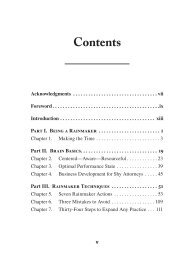(Bk Business) Carol Kinsey Goman Ph.D.-The Nonverbal Advantage_ Secrets and Science of Body Language at Work -Berrett-Koehler Publishers (2008)
Just
Just
Create successful ePaper yourself
Turn your PDF publications into a flip-book with our unique Google optimized e-Paper software.
Introduction<br />
5<br />
reacted more favorably to teachers who used nonverbal<br />
immediacy cues: eye contact, affirm<strong>at</strong>ive head nodding, leaning<br />
forward, <strong>and</strong> smiling. Increasing immediacy behaviors<br />
dram<strong>at</strong>ically improves students’ motiv<strong>at</strong>ion, how much they<br />
like a class, <strong>and</strong> their willingness to follow the teacher’s or<br />
pr<strong>of</strong>essor’s recommend<strong>at</strong>ion.<br />
Sales <strong>The</strong> moment salespeople meet prospective customers,<br />
the customers are being judged by how they look <strong>and</strong><br />
wh<strong>at</strong> they do. <strong>The</strong> process takes about seven seconds, but<br />
the impression lasts. Making or breaking a sale <strong>of</strong>ten depends<br />
on the nonverbal signals th<strong>at</strong> are exchanged during this initial<br />
contact. Attire, body positions, expressions, facial movements,<br />
<strong>and</strong> eye contact are all factors to be understood <strong>and</strong><br />
managed by the successful salesperson.<br />
Negoti<strong>at</strong>ion Masterful negoti<strong>at</strong>ion results from being able<br />
to correctly read between the lines <strong>of</strong> wh<strong>at</strong> people are saying.<br />
One <strong>of</strong> the most powerful ways to do this is to acquire an<br />
underst<strong>and</strong>ing <strong>of</strong> body language. Effective negoti<strong>at</strong>ors recognize<br />
when they need to slow down or speed up the negoti<strong>at</strong>ion<br />
process. <strong>The</strong>y know how to relieve anxiety <strong>and</strong> calm<br />
difficult situ<strong>at</strong>ions. R<strong>at</strong>her than relying solely on verbal cues,<br />
however, the primary way they gauge wh<strong>at</strong> is happening is<br />
by w<strong>at</strong>ching for nonverbal behavior th<strong>at</strong> signals someone’s<br />
unconscious, <strong>and</strong> therefore unmonitored, motiv<strong>at</strong>ion.<br />
Healthcare <strong>The</strong> rel<strong>at</strong>ionship between physicians’ nonverbal<br />
communic<strong>at</strong>ion skills <strong>and</strong> their p<strong>at</strong>ients’ s<strong>at</strong>isfaction with<br />
medical care is substantial. Although the physicians’ nonverbal<br />
communic<strong>at</strong>ion skills won’t affect p<strong>at</strong>ients’ r<strong>at</strong>ings <strong>of</strong> the<br />
technical quality <strong>of</strong> care, doctors who are more sensitive to<br />
nonverbal cues <strong>and</strong> who express wh<strong>at</strong> the Medical College <strong>of</strong><br />
Virginia calls “clinical emp<strong>at</strong>hy” cre<strong>at</strong>e higher overall p<strong>at</strong>ient<br />
s<strong>at</strong>isfaction—<strong>and</strong> are sued less <strong>of</strong>ten!




